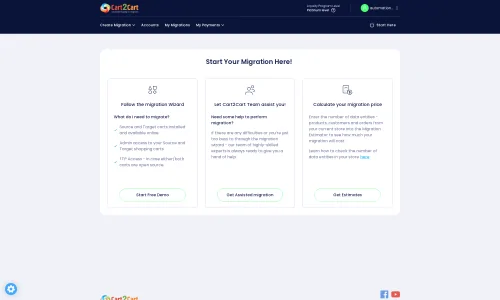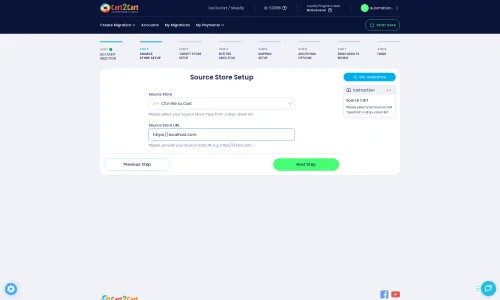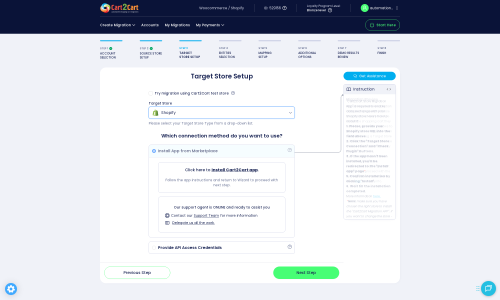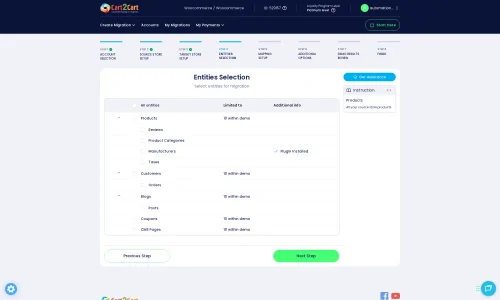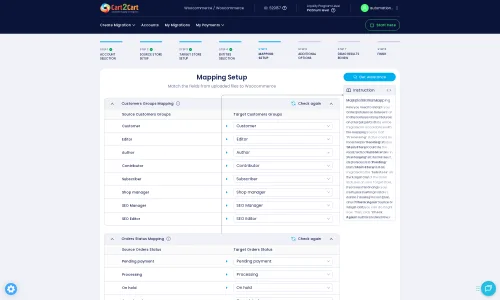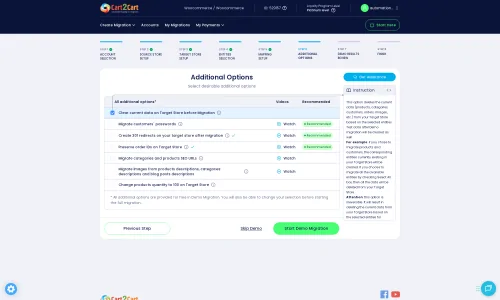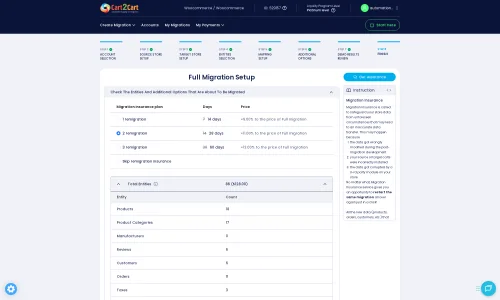Shopping Cart Elite to Shopify Migration - Step-by-Step Guide & Expert Services
Seamless Shopping Cart Elite to Shopify migration is within reach. Ready to move Shopping Cart Elite store to Shopify? Cart2Cart ensures a fast, secure, and SEO-friendly transfer of all your crucial data with zero downtime. Whether you prefer a detailed step-by-step guide to switch from Shopping Cart Elite to Shopify yourself or need expert assistance to transfer data effortlessly, we’ve got you covered. Achieve a flawless Shopping Cart Elite to Shopify migration and unlock new growth for your online store.
What data can be
migrated from Shopping Cart Elite to Shopify
-
Products
-
Product Categories
-
Manufacturers
-
Customers
-
Orders
Estimate your Migration Cost
The price of your migration depends on the volume of data to migrate and the additional migration options you pick. To check the price for Shopping Cart Elite to Shopify conversion, click “Get estimates” and follow the suggested steps.
How to Migrate from Shopping Cart Elite to Shopify In 3 Steps?
Connect your Source & Target carts
Choose Shopping Cart Elite and Shopify from the drop-down lists & provide the stores’ URLs in the corresponding fields.
Select the data to migrate & extra options
Choose the data you want to migrate to Shopify and extra options to customise your Shopping Cart Elite to Shopify migration.
Launch your Demo/Full migration
Run a free Demo to see how the Cart2Cart service works, and when happy - launch Full migration.
Migrating Your E-commerce Store: From Shopping Cart Elite to Shopify
Seamlessly Transition Your Store from Shopping Cart Elite to Shopify
Embarking on an e-commerce platform migration is a significant step towards enhancing your online store's capabilities and reach. If you're currently operating on Shopping Cart Elite and considering a switch to Shopify, you're looking at a move to a more scalable, user-friendly, and feature-rich ecosystem. This comprehensive guide will walk you through the entire replatforming process, ensuring a smooth transition of your valuable store data – from products and customers to orders and reviews – from Shopping Cart Elite to your new Shopify storefront.
Given that direct API connections for Shopping Cart Elite are not universally available through standard migration tools, this guide will detail the most robust and widely supported method: migrating your data via CSV file export from Shopping Cart Elite and then importing it into Shopify using a dedicated migration solution like Cart2Cart. This approach ensures maximum data integrity and allows for meticulous control over your data transfer.
Prerequisites for a Successful Migration
Before initiating your store transfer, a thorough preparation phase is crucial to minimize downtime and prevent data loss. Here’s what you need to have in place:
- Shopping Cart Elite Data Export: You will need to export all your vital store data from Shopping Cart Elite into CSV files. This typically includes products (with SKUs, variants, descriptions, images), product categories, customer records, order history, reviews, CMS pages, and blog posts. Ensure all exported files are complete and well-organized for the import process. If you need assistance with this, consider our CSV.File Data Migration service.
- New Shopify Store Setup: Create a new Shopify store account. Familiarize yourself with the Shopify admin panel and select a suitable plan. Be aware that Shopify's 'Pause and Build' plan might temporarily block orders, so plan accordingly. It's also recommended to disable customer notifications during the migration process to avoid confusion. For reviews, note that Shopify requires an app like 'AirReviews' to properly display them post-migration. For more details on preparing your target platform, refer to our guide on preparing your target store for migration.
- Cart2Cart Store Migration App for Shopify: To facilitate a smooth data import, you will need to install the Cart2Cart Store Migration App from the Shopify App Store. This application acts as the bridge between your exported CSV data and your new Shopify store.
- Data Backup: Always create a full backup of your Shopping Cart Elite store data before starting any migration. While CSV exports are a form of backup, a complete system snapshot is always recommended as a fail-safe. Review our guide on preparing your source store for migration for more details.
- Time and Resources: Allocate sufficient time for the migration. While the process itself can be quick, reviewing, testing, and making post-migration adjustments will require dedicated effort. Consider the potential impact on your SEO rankings and link equity, and plan for 301 redirects.
Performing the Migration: A Step-by-Step Guide
This section outlines the process using a typical migration wizard interface, guiding you from your Shopping Cart Elite CSV files to your new Shopify store.
Step 1: Kickstarting Your Migration
Begin by accessing the migration wizard. This initial screen will offer options to start a new migration, request expert assistance, or estimate costs.
Step 2: Configuring Your Source Store (Shopping Cart Elite via CSV)
Here, you will specify your source platform and upload your exported Shopping Cart Elite data.
- Select "CSV File to Cart": From the dropdown menu, choose "CSV File to Cart" as your source platform. This method is used when directly connecting to a platform like Shopping Cart Elite is not feasible via API.
- Upload CSV Files: Upload the prepared CSV files containing your products, customers, orders, categories, and other entities exported from Shopping Cart Elite. The wizard will guide you through mapping these files to the correct data types. Supported entities for CSV migration typically include products, product categories, manufacturers, reviews, customers, orders, invoices, taxes, stores, coupons, CMS pages, and blog posts.
Step 3: Setting Up Your Target Store (Shopify)
Now, connect your new Shopify store to the migration wizard.
- Select "Shopify": Choose "Shopify" from the target platform dropdown menu.
- Provide Store URL: Enter the URL of your new Shopify store.
- Install Cart2Cart App: The recommended connection method is to install the Cart2Cart Store Migration App directly from the Shopify Marketplace. Click the provided link, follow the installation instructions on Shopify, and then return to the wizard. This method typically uses the 'App' connection type (install button, cookies, xcsrfToken). Alternatively, you can opt to provide API access credentials, though the app method is usually simpler. For more information on securing access credentials, refer to The Short & Essential Guide to Access Credentials for Cart2Cart. We also address concerns like is it safe to provide your company with my access details.
Step 4: Selecting Data Entities
This crucial step allows you to specify exactly which data types you wish to transfer to Shopify.
- Choose Entities: The wizard will present a checklist of all supported entities for migration, such as Products, Product Categories, Customers, Orders, Reviews, CMS Pages, Blogs, and Coupons.
- Select All or Specific: You can select the "All entities" checkbox for a complete data transfer or individually pick the data entities relevant to your needs. Shopify supports a wide range of data entities, including products, product categories, product reviews, customers, orders, CMS pages, gift cards, coupons, price rules, blogs, and blog posts.
Step 5: Data Mapping
Data mapping ensures that your Shopping Cart Elite data fields correctly align with Shopify's structure, maintaining data integrity and consistency.
- Map Customer Groups and Order Statuses: Match your source store's customer groups (e.g., 'Wholesale,' 'Retail') and order statuses (e.g., 'Pending,' 'Processing,' 'Completed') to their corresponding equivalents in Shopify. This is vital for maintaining customer segmentation and order workflow.
- Product Attributes and Variants: Ensure that product attributes and variants are correctly mapped to Shopify's product structure, preserving your SKUs and product variations.
Step 6: Choose Additional Options & Run Demo
Enhance your migration with optional features and perform a demo migration to verify your settings.
- Select Additional Options: The wizard offers various options to tailor your migration, such as:
- Clear Target Store Data: (Clear current data on Target store before migration option) This is useful if you've been testing and want a fresh start.
- Preserve Order IDs: (How Preserve IDs options can be used?) Maintain original order numbers for continuity.
- Migrate Images in Description: Essential for keeping your product descriptions visually rich.
- Create 301 SEO URLs: Crucial for preserving your SEO rankings and link equity by redirecting old URLs to new ones on Shopify.
- Migrate All Categories / Migrate Groups to Tags: Important for organizing your product hierarchy.
- Concat Short Description: Combines short and full descriptions if needed.
- Run Free Demo Migration: Highly recommended! A demo migration transfers a limited number of entities (e.g., 10-20 products, customers, orders) for free. This allows you to inspect the migrated data on your Shopify store, identify any potential issues, and make adjustments before committing to the full migration. Pay attention to how your product variants, customer data, and order details appear.
Step 7: Initiate Full Migration
Once you're satisfied with the demo results, proceed with the complete data transfer.
- Review & Purchase: The wizard will display a summary of your selected entities, additional options, and the total cost. You can also opt for Migration Insurance, which allows for re-migrations within a certain period, offering peace of mind. Learn more about How Migration Insurance works?.
- Start Full Migration: Confirm all details and initiate the full migration. The process will run in the background, allowing you to monitor its progress.
Post-Migration Steps
After the data transfer is complete, several critical steps are necessary to ensure your new Shopify store is fully functional and optimized.
- Verify Data Integrity: Thoroughly check all migrated data on your Shopify store. This includes:
- Products: Ensure all products, SKUs, images, descriptions, variants, and pricing are correct.
- Customers: Verify customer accounts, addresses, and order history.
- Orders: Confirm order details, statuses, and associated customer information. Note that for Shopify, the 'fulfilled date' will reflect the migration date if not specifically preserved. You can learn more here: What will be the Fulfilled date on Shopify target store?
- Reviews & CMS Pages: Check if reviews are correctly linked (remembering the need for a Shopify review app) and that all CMS pages and blog posts are displayed as intended.
- Configure Shopify Settings: Set up essential store configurations specific to Shopify:
- Shipping & Taxes: Define your shipping zones, rates, and tax settings. Shopify offers robust options for multi-tax configuration.
- Payment Gateways: Integrate your preferred payment providers.
- Themes & Design: Customize your Shopify theme to match your brand's aesthetic.
- Apps & Plugins: Install any necessary apps from the Shopify App Store to extend functionality (e.g., for SEO, marketing, customer service).
- Implement SEO Strategies:
- 301 Redirects: Ensure all necessary 301 redirects are in place from your old Shopping Cart Elite URLs to your new Shopify URLs to preserve SEO rankings and link equity.
- Metadata: Review and update product and page metadata for SEO optimization.
- Google Analytics & Search Console: Update your Google Analytics and Google Search Console settings to reflect your new Shopify domain.
- Extensive Testing: Conduct comprehensive testing of your new store:
- Checkout Process: Perform test orders to ensure the entire checkout flow works flawlessly.
- Customer Accounts: Test login, password resets, and account management functionalities.
- Mobile Responsiveness: Verify that your store is fully responsive and looks great on all devices.
- Go Live: Once everything is tested and verified, update your DNS settings to point your domain to your new Shopify store. Consider removing or redirecting your old Shopping Cart Elite store completely after a transition period.
By following these detailed steps, you can successfully transition your e-commerce business from Shopping Cart Elite to Shopify, leveraging Shopify's powerful platform for future growth and an enhanced user experience. Should you encounter any challenges or require expert assistance at any stage, do not hesitate to Contact Us or check our Frequently Asked Questions section. Our services, such as Recent Data Migration Service or Migration Customization Service, are designed to support your unique migration needs.
Ways to perform migration from Shopping Cart Elite to Shopify
Automated migration
Just set up the migration and choose the entities to move – the service will do the rest.
Try It Free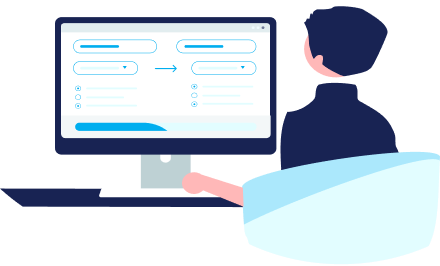
Data Migration Service Package
Delegate the job to the highly-skilled migration experts and get the job done.
Choose Package

Benefits for Store Owners

Benefits for Ecommerce Agencies
Choose all the extra migration options and get 40% off their total Price

The design and store functionality transfer is impossible due to Shopping Cart Elite to Shopify limitations. However, you can recreate it with the help of a 3rd-party developer.
Your data is safely locked with Cart2Cart
We built in many security measures so you can safely migrate from Shopping Cart Elite to Shopify. Check out our Security Policy
Server Security
All migrations are performed on a secure dedicated Hetzner server with restricted physical access.Application Security
HTTPS protocol and 128-bit SSL encryption are used to protect the data being exchanged.Network Security
The most up-to-date network architecture schema, firewall and access restrictions protect our system from electronic attacks.Data Access Control
Employee access to customer migration data is restricted, logged and audited.Frequently Asked Questions
What factors determine the cost of migrating from Shopping Cart Elite to Shopify?
Will my existing Shopping Cart Elite store design be transferred to Shopify?
How can I validate data accuracy after migrating from Shopping Cart Elite to Shopify?
Should I use an automated tool or hire an expert for my Shopping Cart Elite to Shopify migration?
What data entities can be migrated from Shopping Cart Elite to Shopify?
How can I preserve SEO rankings when switching from Shopping Cart Elite to Shopify?
How long does a Shopping Cart Elite to Shopify store migration typically take?
Can customer passwords be migrated from Shopping Cart Elite to Shopify?
Will my Shopping Cart Elite store go offline during migration to Shopify?
Is my data secure during the Shopping Cart Elite to Shopify transfer?
Why 150.000+ customers all over the globe have chosen Cart2Cart?
100% non-techie friendly
Cart2Cart is recommended by Shopify, WooCommerce, Wix, OpenCart, PrestaShop and other top ecommerce platforms.
Keep selling while migrating
The process of data transfer has no effect on the migrated store. At all.
24/7 live support
Get every bit of help right when you need it. Our live chat experts will eagerly guide you through the entire migration process.
Lightning fast migration
Just a few hours - and all your store data is moved to its new home.
Open to the customers’ needs
We’re ready to help import data from database dump, csv. file, a rare shopping cart etc.
Recommended by industry leaders
Cart2Cart is recommended by Shopify, WooCommerce, Wix, OpenCart, PrestaShop and other top ecommerce platforms.



